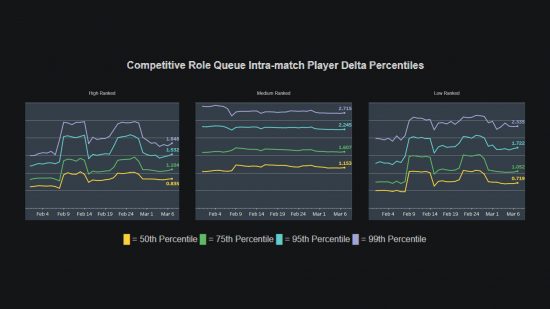If your Overwatch 2 competitive match has been going downhill lately, you’re not alone. Blizzard has taken drastic measures to try to salvage the narrative around the matchmaking system for its hero-focused multiplayer game, admitting that “we risk looking like a broken record.” Instead, game director Aaron Keller presents Overwatch 2 stats and graphics to detail where the system fails and what the current plans are for the future.
Keller acknowledges that matchmaking is a big deal for many players, admitting that “‘We’re working on it and it’s getting better’ isn’t the best message, especially when players are having bad matches.” So instead of just offering promises and vague hand gestures, he gives us some stats as part of the team’s ongoing efforts to improve communication with the community.
Keller notes that the changes made over the previous week “significantly reduced the skill gap between players in a match for both high and low MMR matches.” To show this, he points to three charts (see below) and highlights two recent spikes that have caused significant gaps between players, with some separated by up to ten divisions ranked in the worst 1% of cases.
He comments that some of the skill gap is almost inevitable due to player pooling, which allows players as high as masters to group together with others who are up to five divisions above their current skill rank. However, a strange adjustment made to Overwatch 2 Season 3 had a distinctly negative impact, where the developer’s changes to all queue types (competitive, unranked, and arcade) were all tied together.
Ya sea intencionalmente o no, Keller says that estos modos ahora se tratarán por separado nuevamente, lo que significa que el team podría optar por priorizar tiempos de espera más cortos para los modos de juego casual, pero aumentar el enfoque en obtention una partida equilibrada en competition. What they plan to do with the new Mystery Heroes competitive mode is anyone’s guess, but I guess chaos is the name of the game there.
Keller says the team now intends to “tweak these values to narrow the skill gap in the competition as much as possible while keeping an eye on cooldowns for this mode.” He adds that a new system introduced with the latest patch allows Overwatch 2’s matchmaker to rank groups that have a similar rank difference between their members.
All of this data is great, but in the end, it’s the results that matter. Nothing is likely to turn players away from a competitive multiplayer game like Overwatch 2 as quickly as dramatically unbalanced matchmaking. Personally, I’d like to see players be able to choose to prioritize closer games over faster matchmaking. I’ll take a few extra minutes playing on my phone each time if it means getting closer and better in matches when they come up.
In conclusion, Keller notes that the team is eager to hear player feedback. Regardless of the topic, it’s true that the Overwatch 2 team has felt more open and forthright about its development process in 2023, and ultimately that should spark a warmer feeling within the community.
Keller is already responding to comments on Twitter, such as consultant whether unranked play is too lazy with no party restrictions, or whether the ability to play with friends of all skill levels in casual modes is too important to lose. It’s certainly a difficult balance to strike, but it looks like the Overwatch 2 team is considering all options at this time.
Keep an eye on our Overwatch 2 tier list to see who the best characters are right now, plus all the details we know about Overwatch 2 Season 4. If you’re wondering when the Overwatch 2 PvE release date is , we will be sure to keep you informed of all developments.

